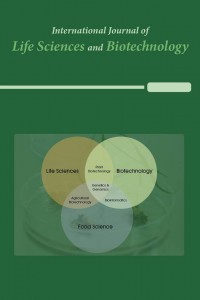Orta Karadeniz Bölgesinden Toplanan Dactylis glomerata, Festuca arundinacea, Trifolium repens Genotiplerinin Çekirdek DNA İçeriklerinin Belirlenmesi ve Ploidi Analiziyle Tür Teşhisinde Kullanılması
Festuca arundinecea, Dactylis glomerata, Trifolium repens, Flow sitometri, Ploidi
Determination of Core DNA Contents and Use in Species Identification by Ploidy Analysis of Dactylis glomerata ssp., and Festuca arundinaceae ssp. of Trifolium repens ssp. Collected from the Central Black Sea Region
Festuca arundinecea, Dactylis glomerata, Trifolium repens, Flow Cytometry, Ploidy,
___
- 1. Anonim, Karadeniz Tarımsal Araştırma Enstitüsü Toprak Gübre ve Su Laboratuarı, Samsun, 2014.
- 2. Alay, F., K. İspirli, and N. Çankaya, Yıllara Göre Yem Bitkileri Ekiliş Alanları, Kaba Yem Üretimi, Tohum İthalatı ve İhracatı. SAMTİM, 2015. Sayı: 50 ISSN 1305-7588.
- 3. Ayan, İ., et al.,. Orta Karadeniz Bölgesi’nde Bazı Buğdaygil Yembitkilerinin Toplanması, Tanımlanması ve Kültüre Alınma Olanaklarının Araştırılması. 106 O 738 nolu TÜBİTAK Proje Sonuç Raporu, 2011.
- 4. Creber, L.H., et al., Variation in DNA C value in natural populations of Dactylis glomerata’’ School of Pure and Applied Biology. Universitv of Wales, PO Box 915, Cardiff CFl 3TL, 1994. 128, 555-561.
- 5. Davis, P.H. Flora of Turkey and the East Aegean Islands. – Pp:.? in Davis PH (ed.) , Flora of Turkey and the East Aegean Islands 9. 1985. Edinburgh: Edinburgh University.
- 6. Özbek, H. and S. Keskin, Standart sapma mı yoksa standart hata mı? Van Tıp Dergisi, 2007. 14(2): p.64-67.
- 7. Reeves, G., et al., Genome Size is Negatively Correlated with Altitude in Natural Populations of Dactylis glomerata. Annals of Botany, 1998. 82: p. 99–105.
- 8. Rizza, D. M., et al., Genetic diversity and DNA content of three South American and three Eurasiatic Trifolium species. Genet. Mol. Biol. 2007. vol.30 no.4.
- 9. Šmarda, P., et al., Ploidy level variability of some Central European fescues (Festuca subg. Festuca, Poaceae) Biologia. 2005. 60/1:p. 25—36.
- 10. Smarda P., et al.,. Genome Size and GC Content Evolution of Festuca: Ancestral Expansion and Subsequent Reduction. Annals of Botany, 2008. 101: p.421–433.
- 11. Tuna, M., et al., Cite as Characterization of natural orchardgrass (Dactylis glomerata L.) populations of the Thrace Region of Turkey based on ploidy and DNA polymorphism. 2004. 135(1): p.39–46.
- 12. Tuna, S, G., et al., Flow Sitometri ile Çok Yıllık Buğdaygil Yem Bitkisi Genetik Kaynaklarının Karakterizasyonu. Tarla Bitkileri Merkez Araştırma Enstitüsü Dergisi, 2016. 25 (2):p.7-12.
- 13. Turan, İ. Temel İstatistik, https://s3.amazonaws.com/academia.edu.documents/2011.
- 14. Vilhar, B., et al., Genome size and the nucleolar number as estimators of ploidy level in Dactylis glomeratain the Slovenian Alps. Plant Systematics and Evolution, 2002. 234(1):p.1–13.
- 15. Vižintin, L., B. Javornik, and B. Bohanec, Genetic characterization of selected Trifolium species as revealed by nuclear DNA content and ITS rDNA region analysis. Plant Science, 2006. 170(1).p.859-866.
- Yayın Aralığı: Yılda 3 Sayı
- Başlangıç: 2018
- Yayıncı: International Society of Academicians
Nahdhoit AHAMADA RACHID, Nihal DOĞRUÖZ GÜNGÖR
Plastik Biyodegradasyonu: Genel Sorunlar ve Biyoteknolojik Çözümler
Haruna SAIDU, Olanrewaju SALAU, Shaza Eva MOHAMAD
Lactobacillus acidophilus and Non-Digestible Carbohydrates: A Review
Haia Abobakr AL-KAF, Noorazwani ZAİNOL, Roslinda Binti Abd MALEK, Fahrul ZAMAN HUYOP
Genotypic differences in aluminum tolerance of cowpea accessions utilizing germination parameters
Fatih ALAY, Kadir İSPİRLİ, Necda ÇANKAYA, Metin TUNA, İlknur AYAN
Alkanna strigosa Boiss.&Hohen. (Boraginaceae) Kökünden Doğal Boya Eldesi
Hasan AKAN, Mehmet Maruf BALOS
The chronic toxicity studies of camellia seed oil containing tea saponins on mice blood and organs
Hadeil AHMED, Abdalbasit MARIOD, Tarig HAMMODA
Cadmium stress in barley seedlings: Accumulation, growth, anatomy and physiology
İbrahim İlker ÖZYİĞİT, Aizada ABAKİROVA, Aslı HOCAOĞLU-ÖZYİĞİT, Gülbübü KURMANBEKOVA, Kadyrbay CHEKİROV, Bestenur YALÇIN, İbrahim Ertuğrul YALÇIN
İbrahim İlker ÖZYİĞİT, Dilbara BAKTİBEKOVA, Aslı HOCAOĞLU-ÖZYİĞİT, Gülbübü KURMANBEKOVA, Kadyrbay CHEKİROV, İbrahim Ertuğrul YALÇIN
